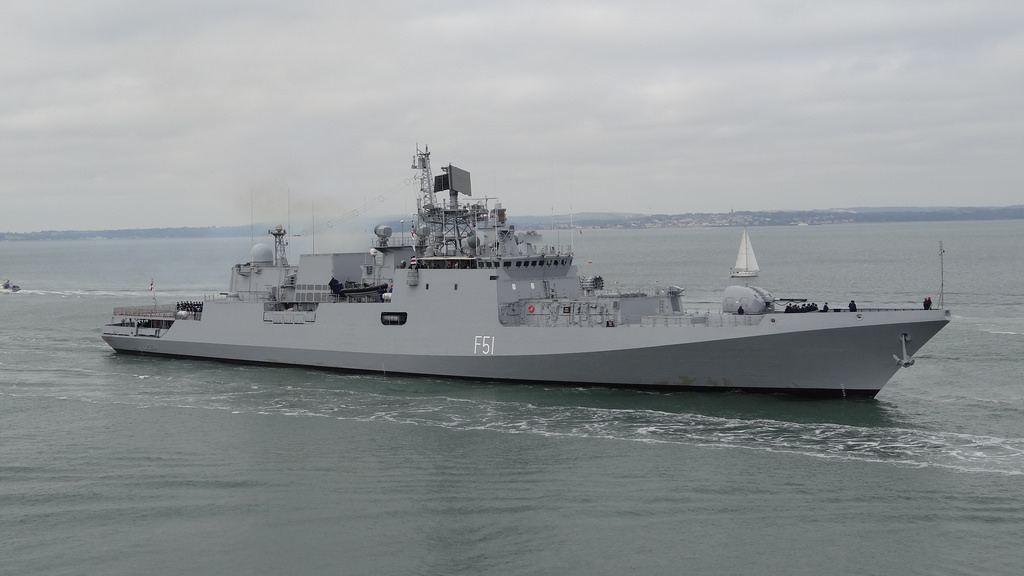India clears new frigate deal
September 18, 2018 | Expert Insights

New Delhi has green-lit its biggest arms deal worth $2.2Bn with Russia for 4 advanced frigates.
India’s new deal comes in defiance of US sanctions on Moscow, which prevent foreign arms sales and curbs oil exports.
Background
Russia is considered an important ally for India. The two countries have shared strategic, military, economic and diplomatic relations for years. The Indo-Russian intergovernmental commission is one of the largest comprehensive governmental mechanisms that India has had with any country internationally. However, the 1960s were testing times for the two, when Russia started getting closer to Pakistan. After the 1965 India-Pakistan war, Russia reduced its support to India on the Kashmir issue. However, ties normalized and became strong in its aftermath. India’s participation in the Non-Aligned Movement helped it maintain a position of neutrality during the Cold War and maintain cordial relations with Russia.
Indo-Russian relations in the 21st century is based on robust bilateral trade, warm diplomatic relations and cultural exchanges. Russia has been India’s strategic partner and main defence supplier for close to 20 years, whereas India has been a reliable trade partner for Moscow.
However, the recent US sanctions on Russia has strained the trade relations. Additionally, India’s recent defence-related procurements from the US has pushed Moscow to sell military hardware to Pakistan, India’s regional rival. This is largely considered to be a minor hiccup in a largely stable bilateral relation.
Analysis
India has cleared the way for its biggest deal yet with Russia, with Delhi reportedly set to sign a deal to purchase $2.2 billion worth of Russian ships. It comes despite US sanctions aimed at deterring business with Moscow.
After revitalizing defence ties with the US earlier this month, India has now turned to Russia to acquire four new warships for its Navy, sources quoted by the Economic Times said.
The deal is expected to be signed by Indian Prime Minister Narendra Modi and Russian President Vladimir Putin at a meeting in Delhi on October 5.
The deal will see India acquiring advanced Talwar-class frigates, also known as Project 11356 frigates. Two of them will reportedly be built from scratch in a Goa shipyard, while the remaining two will be sent from Russia.
It has been difficult for India to acquire weapons from Russia, as the US sanctions are complicating the process. The US sanctions were implemented under the CAATSA (Countering America's Adversaries Through Sanctions Act) following the annexation of Crimea by Russia following a referendum.
However, in defiance of US sanctions, it looks like India will go ahead with the deal by clearing the funds in rupees rather than in dollars. Indian Defence Minister Nirmala Sitharaman indicated on Monday that her country would not allow its ties with Russia to be impacted by US sanctions. She added that negotiations on the S-400 missile deal with Russia were almost complete, hinting that India was on course to finalize it soon.
News of the reported frigate deal comes just after India signed what was branded a “milestone” agreement with the US. That agreement, signed in Delhi at the beginning of September, will purportedly see India gaining access to advanced defence systems.
The report comes just days after India's external affairs minister, Sushma Swaraj, said that the two countries "enjoy a special and privileged strategic partnership...India attaches the highest importance to its relations with Russia."
The new deal comes at the heels of New Delhi’s decision to pursue the Russian S-400 anti-aircraft missile defence system. This separate deal would be valued at $5.5bn. Unlike Turkey, Washington has no clear objections to India’s purchase of the S-400 system.
Counterpoint
Despite an extensive campaign to promote domestic manufacturing, the Modi-led government has purchased these new frigates from Russia. Although 2 frigates will be built from the keel-up in Goa, the contractors will be Russian companies instead of the Indian shipbuilders.
Additionally, India’s decision to purchase military hardware from both the US and Russia shows signs of indecision in foreign policy making. This may prevent reliance on a single supplier but it also reduces the clarity on India’s essential defence procurement plans for the future.
Assessment
Our assessment is that India is looking to use Russia’s expertise in shipbuilding to acquire state-of-the-art attack frigates. New Delhi is looking to boost its presence in the Indian Ocean and 4 new frigates will provide crucial power projection in the region. We believe that India will attempt to retain Russia as a strategic partner and friend. We also feel that India will try to balance its relation with Washington and Moscow without antagonising one or the other.








Comments